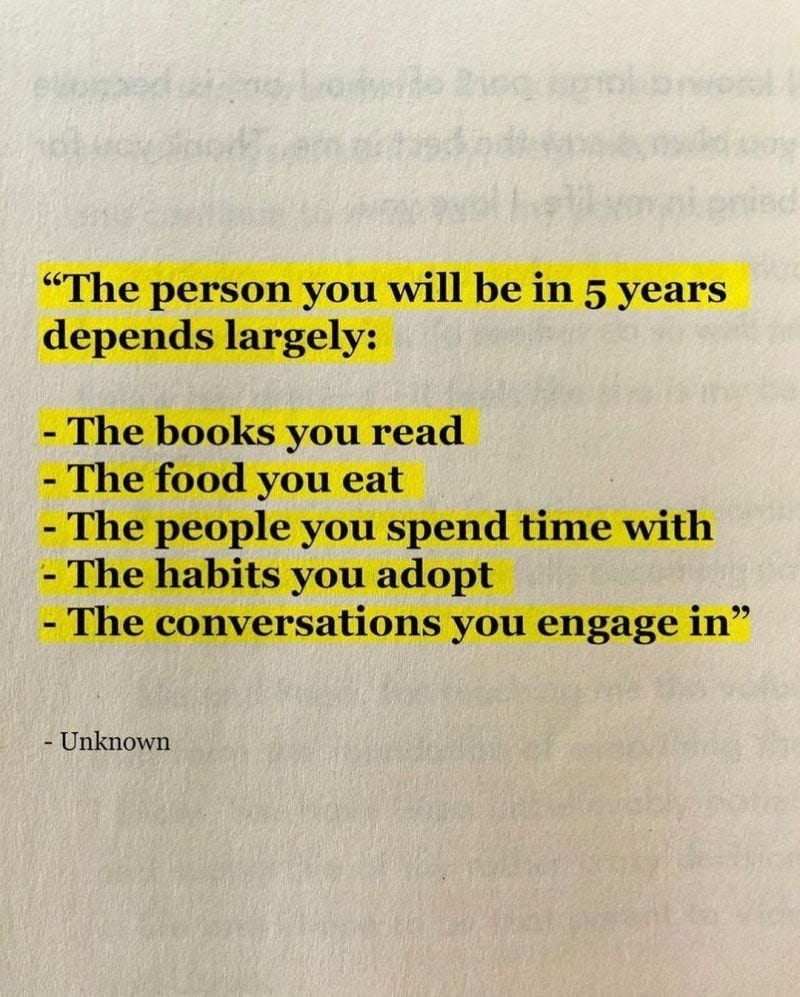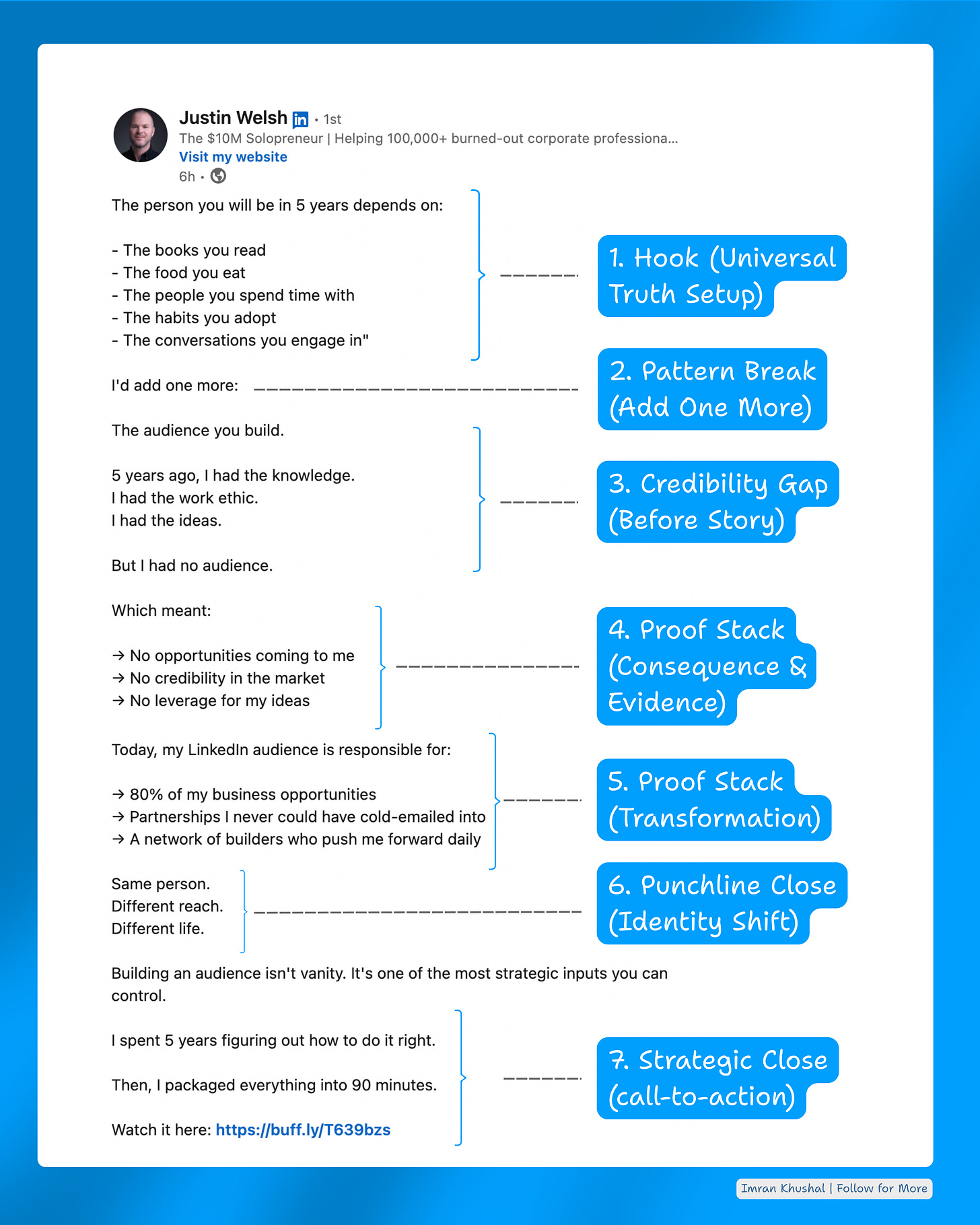Steal this proven framework from Justin Welsh
I reverse-engineered it so you can use it in your next post!
Hey friend,
I took one of Justin Welsh’s posts and reverse-engineered it.
It’s built on a simple quote you’ve probably seen a hundred times — but what he did with it is pure genius.
Let’s unpack it.
1. The Visual Hook (Borrowed Wisdom)
He opens not with words — but with a visual.
That yellow-highlighted quote:
“The person you will be in 5 years depends on:
– The books you read
– The food you eat
– The people you spend time with
– The habits you adopt
– The conversations you engage in”
It’s old wisdom, probably from a self-help book.
But that’s the point — it’s familiar.
He borrows a truth that people already trust.
That’s allusion — using cultural recognition to lower the reader’s guard.
2. The Hook (Universal Truth)
He starts where everyone nods:
“The person you’ll be in 5 years depends on…”
That’s rhythm, repetition, and shared belief.
It builds instant alignment before the twist.
3. The Pattern Break (Add One More)
Then he says:
“I’d add one more: The audience you build.”
That single line reframes everything.
We move from personal growth to public leverage.
That’s contrast — the device that turns recognition into surprise.
4. The Before Story (Credibility Gap)
Next, he opens up.
“5 years ago, I had the knowledge.
I had the work ethic.
I had the ideas.
But I had no audience.”
That’s antithesis — same person, different result.
It’s human. It earns trust.
5. The Proof Stack (Pain → Payoff)
He shows both sides.
First the pain:
→ No opportunities
→ No credibility
→ No leverage
Then the payoff:
→ 80% of business
→ Partnerships
→ A builder network
Notice the arrows?
That’s rhythm. It keeps readers scrolling.
6. The Punchline (Identity Shift)
“Same person.
Different reach.
Different life.”
That’s not luck — it’s epistrophe.
Repetition that lands emotionally.
7. The Strategic Close (Soft CTA)
He ends with:
“Building an audience isn’t vanity. It’s one of the most strategic inputs you can control.
I spent 5 years figuring out how to do it right.
Then, I packaged everything into 90 minutes.”
That’s not selling.
It’s reframing — turning audience growth from ego to leverage.
8. The Hidden Element — The Visual Quote
That opening image isn’t decoration.
It’s borrowed wisdom — the credibility anchor that makes everything that follows believable.
By starting with a familiar visual, he builds emotional trust before introducing his idea.
That’s the overlooked move most creators miss.
The Full 8-Part Framework
Visual Hook (Borrowed Wisdom) — start with a quote or image people recognize.
Hook (Universal Truth) — restate it in your own words.
Pattern Break (Add One More) — add your unique differentiator.
Credibility Gap (Before Story) — show you had everything except this one thing.
Proof Stack (Pain) — list what that cost you.
Proof Stack (Payoff) — show the transformation.
Punchline Close (Identity Shift) — end with a rhythmic 3-line truth.
Strategic Close (Soft CTA) — reframe the insight and invite action.
The Fill-in-the-Blanks Template
[1] Visual Hook (Borrowed Wisdom)
“The [result] you’ll have in [time frame] depends on:
– [Input 1]
– [Input 2]
– [Input 3]
– [Input 4]
– [Input 5]”
[2] Hook (Universal Truth)
“The [result] you’ll have in [time] depends on…”
[3] Pattern Break (Add One More)
“I’d add one more: [Your differentiator].”
[4] Credibility Gap (Before Story)
“[X years] ago, I had [trait 1], [trait 2], [trait 3]. But I didn’t have [differentiator].”
[5] Proof Stack (Pain)
“Which meant:
→ [Negative 1]
→ [Negative 2]
→ [Negative 3]”
[6] Proof Stack (Payoff)
“Today, [positive 1]
→ [positive 2]
→ [positive 3]”
[7] Punchline Close (Identity Shift)
“Same [you].
Different [lever].
Different [result].”
[8] Strategic Close (Soft CTA)
“[Reframe your differentiator].
I spent [time] learning it.
Now I’ve [shared/packaged it] in [offer].”
Takeaway
Most creators chase originality.
Justin Welsh mastered recognition.
He starts with something everyone already trusts,
adds one twist, and lets rhythm, proof, and story do the rest.
That’s not luck.
That’s structure.
Now let’s talk about you.
Are you ready to start winning high-value clients from LinkedIn?
Take my quiz and find out exactly what’s holding you back.
Build your brand,
Imran




